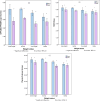Mediation role of cardiorespiratory fitness on association of physical activity and physical literacy among 8-12 years old children: the PAK-IPPL cross-sectional study
- PMID: 39346638
- PMCID: PMC11427255
- DOI: 10.3389/fped.2024.1383670
Mediation role of cardiorespiratory fitness on association of physical activity and physical literacy among 8-12 years old children: the PAK-IPPL cross-sectional study
Abstract
Background: The effect of cardiorespiratory fitness (CRF) on the relationship of physical activity (PA), and physical literacy (PL) in 8-12 Pakistani children are largely unknown. Therefore, this study aims to examine the mediating role of CRF in the relationship between PA and PL in this demographic.
Methods: This cross-sectional study involved 1,360 children aged 8-12 (mean age = 10.00, SD = 1.41 years) from 85 higher secondary schools in South Punjab, Pakistan. Data were collected during the 2020-2021 academic year using the Canadian Assessment of Physical Literacy-2 (CAPL-2) protocol to assess physical activity (PA), Body Mass Index (BMI), and PL levels. CRF was measured using the PACER (Progressive Aerobic Cardiovascular Endurance Run) test. Descriptive statistics, independent samples t-tests, Chi-squared tests, and Generalized Additive Models for Location, Scale, and Shape (GAMLSS) were used for age and sex-specific CAPL-2 scoring. Associations among components were evaluated through Pearson's correlation, multivariate logistic regression, and mediation analyses.
Results: The study revealed that boys had significantly higher scores in CRF, PA, and PL across all age groups compared to girls (p < 0.001), with boys' scores being 20%, 10%, and 14% higher, respectively, than those of girls. Conversely, overweight children showed significantly reduced PA and PL levels (p < 0.001). An inverse correlation was found between BMI and CRF (r 2 linear = 0.022; quadratic = 0.028). CRF scores had significant negative correlations BMI (r = -0.143) and positive associations with MVPA, PA, DB, and PL (r ranging from 0.241 to 0.624). CRF was observed to partially mediate the association between MVPA and PL. The direct impact of PA on PL was significant and meaningful (β = 0.002, p < .001). Additionally, the indirect effect of PA on PL through CRF was also significant (β = 0.001, p < .001), indicating that CRF serves as an important mediator in this relationship. The combined total effect of PA on PL, which includes both direct and mediated pathways, was robust and highly significant (β = 0.003, p < .001).
Conclusion: The study revealed a strong positive correlation between CRF, PA, and PL, but a negative one with BMI in South Punjab children aged 8-12. Notably, CRF and PA emerged as significant predictors of PL levels in this population. Consequently, interventions that are both systematic and targeted towards improving these factors should be implemented as strategies to enhance children's PL levels and promote physically active behaviors.
Keywords: South Punjab Pakistan; cardiorespiratory fitness; childhood adiposity; mediation analysis; physical activity; physical literacy; public health.
© 2024 Hadier, Yinghai, Long, Hamdani and Hamdani.
Conflict of interest statement
The authors declare that the research was conducted in the absence of any commercial or financial relationships that could be construed as a potential conflict of interest.
Figures






References
-
- Observatory, G.O. Scorecards—Atlas of Child Obesity (Pakistan). (2023). Available online at: https://data.worldobesity.org/publications/?cat=3#PK (Accessed January 19, 2023).
-
- Nezondet C, Gandrieau J, Bourrelier J, Nguyen P, Zunquin G. The effectiveness of a physical literacy-based intervention for increasing physical activity levels and improving health indicators in overweight and obese adolescents (CAPACITES 64). Children (Basel). (2023) 10(6):956. 10.3390/children10060956 - DOI - PMC - PubMed
LinkOut - more resources
Full Text Sources
Research Materials
Miscellaneous

